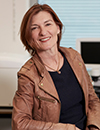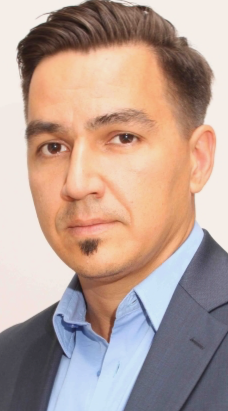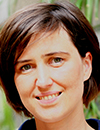Co-Located Conference AgendasCirculating Biomarkers and Extracellular Vesicles Europe 2023 | Lab-on-a-Chip and Microfluidics Europe 2023 | Organoids and Spheroids Europe 2023 | Point-of-Care, Biosensors and Rapid Diagnostics Europe 2023 | 

Monday, 19 June 2023 |
For Logistics and Programming Details for Day 1 of the Conference Please Consult the Agenda for Lab-on-a-Chip and Microfluidics Track |
| |
Tuesday, 20 June 202308:00 | Morning Coffee, Tea and Networking in the Exhibit Hall | |
Session Title: Emerging Themes in Organoids and Spheroids, circa 2023 |
| | |
Venue: Rotterdam Room -- Hilton Rotterdam |
| | 08:05 | Development and Implementation of a Joint-on-Chip
Marcel Karperien, Head Department of Developmental BioEngineering, TechMed Centre, University of Twente, Netherlands
| 08:30 | Modeling Heterogenous Responses to DNA-Damaging Cancer Drugs
Bart Westendorp, Assistant Professor, Faculty of Veterinary Medicine, Utrecht University The Netherlands, Netherlands
Unraveling mechanisms of acquired drug resistance in solid cancers is a major goal to improve the prognosis of cancer patients. An important concept in cancer drug resistance is the presence of (rare) drug-tolerant persister cells, which manage to withstand the effect of cancer medication by modifying their gene expression program, metabolism, and proliferation speed. But the cell-autonomous and environmental factors that determine whether -and how frequently- such persister cells emerge are still poorly understood. In addition, molecular events eventually triggering the emergence of fully drug-resistant relapsed tumors are enigmatic. I will show how we study tolerance and resistance to targeted inhibitors of DNA damage responses in bladder and ovarian cancer. One major challenge is the difficulty to study drug-tolerant persister cells in vivo. I will discuss the possibilities and opportunities for tumor spheroid models in this research field. | 09:00 |  | Keynote Presentation Patient-Derived Organoids at the Forefront of Human Disease Modeling and Therapeutics Development
Robert Vries, CEO, HUB Organoids, Netherlands
|
| 09:30 |  | Keynote Presentation TranSphere: Transporting Live Cell Cultures Under Ambient Conditions Using Organ-on-a-Chip Technology
Peter Ertl, Professor of Lab-on-a-Chip Systems, Vienna University of Technology, Austria
Living cell cultures are widely using in basic to applied research and industrial production. To meet the growing demand for living human cells in biological and medical research as well as pharmaceutical development, cell lines are either ordered and shipped from well-known cell banks around the world or sent between different laboratories. The cryogenic and live transport of cells is not only problematic since high cell viability must be guaranteed, they are also important cost factor considering the prize dry ice and portable incubators. To overcome these limitations, we have developed a microfluidic multi-spheroid array that utilizes the resilience of 3D cell aggregates to cope with physical, chemical and environmental influences such pH changes, mechanical stress and ambient temperatures. In this presentation biochip design, fabrication and initial testing results will be presented. |
| 10:00 |  | Keynote Presentation Human Organoid Technology to Study Human Viral Infections
Dasja Pajkrt, Professor of Viral Pediatric Infectious Diseases, Amsterdam University Medical Center, Head OrganoVIR Labs, Netherlands
Virus research historically relies on research using cell lines or animal models. Organoid technology is highly applicable in the virology field, yet unexplored. Organoid systems can mimic the in vivo human physiological environment and provide tools to study human host-virus interactions. The pathogenesis of a variety of human viruses, such as picornaviruses, HIV and human cytomegalovirus (CMV) is increasingly being studied using these novel human organoid models. Human airway epithelium (HAE) cultures and lung organoids allow for host-pathogen interaction studies on viral infections in the respiratory tract (RT), while human gut and brain organoids facilitate human gastro-intestinal tract (GIT) and brain studies. We established human RT (using HAE and lung organoids) and GIT (using human gut organoids) 3D models to study virus infections such as SARS-CoV2, picornavirus, CMV infections. During the presentation I will share results that are derived from these studies. |
| 10:30 |  | Keynote Presentation Scaffolded Spheroids Enabled by High-Resolution 3D Printing
Aleksandr Ovsianikov, Professor, Head of Research Group 3D Printing and Biofabrication, Technische Universität Wien (TU Wien), Austria
|
| 11:00 |  | Keynote Presentation Mesenchymal Stromal-Stem Cells Promote Intestinal Epithelium Regeneration after Chemotherapy-Induced Damage
Magdalena Lorenowicz, Head of the Advanced In Vitro Model Systems Department, Biomedical Primate Research Center, Netherlands
Allogeneic hematopoietic stem cell transplantation (HSCT) is a curative treatment for leukemia and a range of non-malignant congenital disorders. An essential component of HSCT is the conditioning regimen, consisting of chemotherapy and/or total body irradiation, administrated prior to hematopoietic cell infusion. The success of the therapy is hampered by the development of acute graft-versus-host-disease (aGvHD), in which immune cells from the donor attack healthy recipient tissue, including the liver, skin, and gut. Especially intestinal aGvHD is a life threatening complication. Data from our institution and others demonstrate rescue of ~50% of patients suffering from aGvHD with mesenchymal stromal cells (MSCs) in Phase II clinical trials. However, the underlying mechanism of MSCs contributing to steroid-resistant aGvHD treatment is still unknown. Current models in animal studies and homogeneous cell lines are highly relevant to the field, but these approaches are limited because of the high complexity of human tissues and organs. Immortalized and human primary cell lines have enabled detailed investigation of specific cell types, but do not recapitulate the cellular heterogeneity characteristics for physiological tissues. For this purpose, a suitable in vitro model is needed, which partially recapitulates the in vivo situation of GvHD patients and allows to study the mode of action of MSCs during organ/tissue regeneration in these patients. Here we developed a novel co-culture model of chemotherapy-induced small intestine damaged organoids, self-organizing 3D mini-guts derived from human stem cells, and MSCs and studied the regenerative aspects of MSC treatment on damaged intestinal epithelium by transcriptomic and proteomic analysis. Our study shows that busulfan, the chemotherapeutic commonly used as conditioning regimen before HSCT, damaged the small intestine epithelium by affecting pathways regulating epithelial mesenchymal transition, proliferation, and apoptosis. The MSCs reversed these effects by regulating genes and proteins involved in these pathways, which we also confirmed by functional evaluation of proliferation and apoptosis. Collectively, we demonstrate that our novel in vitro co-culture model is a new valuable tool to mimic the in vivo interplay between damaged intestinal epithelium and MSCs, providing a micro-physiological environment relevant to that of GvHD, and allows to study the molecular mechanism behind the therapeutic effects of MSCs in these patients. |
| 11:30 |  Mass-Density, Weight and Size as Novel Biophysical Parameters to Analyze and Sort 3D Cell Culture Mass-Density, Weight and Size as Novel Biophysical Parameters to Analyze and Sort 3D Cell Culture
Andrea Cristaldi, Senior R&D Specialist, CellDynamics isrl
Introducing a unique approach for the biophysical characterization of 3D cell cultures, dedicated to Live and/or fixed 3D samples ranging from 50 µm sized cell clusters to larger spheroids or organoids up to 500 µm in diameter. The Flow-Based Gravimetric method allows measuring MASS DENSITY, WEIGHT and SIZE of 3D CELL CULTURE as well as performing BIOPHYSICAL-BASED SORTING in a LABEL-FREE manner, preserving samples' STERILITY and VIABILITY. An overview of the growing verified applications will demonstrate how it is now possible to start correlating biological events with biophysical properties, helping researchers gather crucial compactness- and cross-sectional-information, as well as support and improve their workflows. This includes quantitatively monitoring samples’ growth or maturation, standardization and QC prior to further downstream analysis, cell infiltration rates prediction, extracellular matrix production, co-culture growth monitoring, viability trends, drug activity effects and so on. Most importantly, the custom mass-density sorting of a target sub-population, with preserved samples’ sterility and viability, would become the key factor to improve standardization for researchers that want to proceed further with specific downstream analysis minimizing workflow-depending biases.
| 12:00 |  | Keynote Presentation Deployable Extrusion Bioprinting of Compartmental Tumoroids with Cancer Associated Fibroblasts for Immune Cell Interactions
Yan Yan Shery Huang, Professor of BioEngineering, University of Cambridge, United Kingdom
Realizing the translational impacts of three-dimensional (3D) bioprinting for cancer research necessitates innovation in bioprinting workflows which integrate affordability, user-friendliness, and biological relevance. Herein, we demonstrate 'BioArm', a simple, yet highly effective extrusion bioprinting platform, which can be folded into a carry-on pack, and rapidly deployed between bio-facilities. BioArm enabled the reconstruction of compartmental tumoroids with cancer-associated fibroblasts (CAFs), forming the shell of each tumoroid. The 3D printed core–shell tumoroids showed de novo synthesized extracellular matrices, and enhanced cellular proliferation compared to the tumour alone 3D printed spheroid culture. Further, the in vivo phenotypes of CAFs normally lost after conventional 2D co-culture re-emerged in the bioprinted model. Embedding the 3D printed tumoroids in an immune cell-laden collagen matrix permitted tracking of the interaction between immune cells and tumoroids, and subsequent simulated immunotherapy treatments. Our deployable extrusion bioprinting workflow could significantly widen the accessibility of 3D bioprinting for replicating multi-compartmental architectures of tumour microenvironment, and for developing strategies in cancer drug testing in the future. |
| 12:30 |  Bioprinting, Microfabrication and Biomaterials for Advanced Biological 3D Modeling Bioprinting, Microfabrication and Biomaterials for Advanced Biological 3D Modeling
Isabella Bondesson, Application Scientist, Team Lead EMEA, CELLINK
Join us to discover how the latest innovations in 3D bioprinting and biomaterials are transforming the development of biomimetic models. In this seminar, we will explore the systems and materials that enable advanced 3D biofabrication techniques, ranging from vasculature networks, organ-on-a-chip devices and three-dimensional multi-stiffness tissue models with a keen focus on light-based printing technologies, and how they can be complemented with extrusion systems.
Learn about - Combining different 3D bioprinting technologies to create complex, multi-stiffness, and multi-material biomimetic models.
- Recent advancements made in light based bioprinting including novel DLP printing mechanisms.
- Advantages of working with defined, biological matrices of high quality in a wide array of cellular applications to access in-vivo like cellular response in 3D models.
- Successful examples of sustainable, reproducible, and cost-efficient 3D models for rapid advancements within drug discovery, organ-on-a-chip models, and others.
| 13:00 | Networking Luncheon in the Exhibit Hall -- Network with the Exhibitors and View Posters | 13:30 | Biotechnology in Space: New Opportunities for Superior R&D -- Panel Discussion from 13:30 to 14:30 in the Rotterdam Room |
|


 Add to Calendar ▼2023-06-19 00:00:002023-06-20 00:00:00Europe/LondonOrganoids and Spheroids Europe 2023Organoids and Spheroids Europe 2023 in Rotterdam, The NetherlandsRotterdam, The NetherlandsSELECTBIOenquiries@selectbiosciences.com
Add to Calendar ▼2023-06-19 00:00:002023-06-20 00:00:00Europe/LondonOrganoids and Spheroids Europe 2023Organoids and Spheroids Europe 2023 in Rotterdam, The NetherlandsRotterdam, The NetherlandsSELECTBIOenquiries@selectbiosciences.com